MSI GT70 Review: GTX 880M Edition
by Jarred Walton on April 16, 2014 6:00 AM ESTBattery Life
We’ve already covered the gaming aspect of battery life and Battery Boost, but we still haven’t properly addressed “normal” battery life. We ran our two standard tests for battery life; the Light workload simulates constant web surfing by loading four pages every minute until the battery is drained, while the Heavy workload loads the same four pages every 10 seconds while downloading (via Filezilla from a local PC) a constant 8Mbps stream of data and playing back a 1080p MP4 H.264 movie. We have switched to using the Video app on Windows 8, so our updated Heavy workload tends to get better battery life than our previous setup, but the results are at least moderately comparable.
For all of our battery life tests, we optimize the power profile and software to deliver what should be a best-case result. This includes disabling/uninstalling any firewall or anti-virus software, turning off other extraneous utilities that are not needed (e.g. Live Updates), and we use the Power Saver profile. We find a brightness setting as close as possible to 200 nits (cd/m2), set the minimum CPU performance to 0% and the maximum to 100%, disable screen dimming or powering off, and disable sleep/hibernate modes. The HDD/SSD is set to power off after 1 minute of inactivity, and the WiFi is set to maximum power savings. Here are our results.
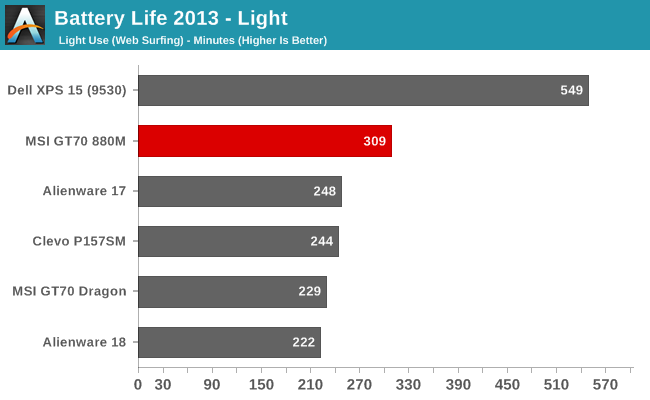
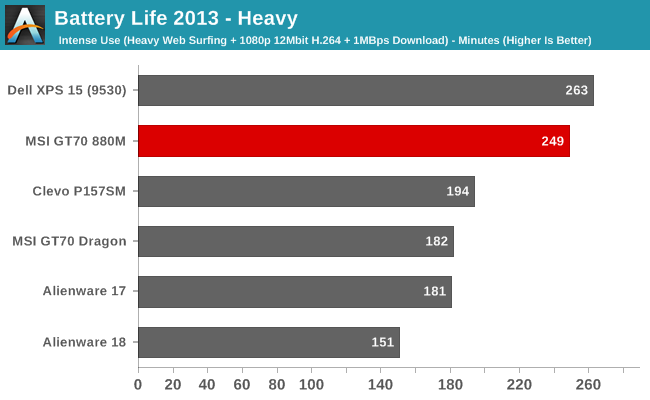

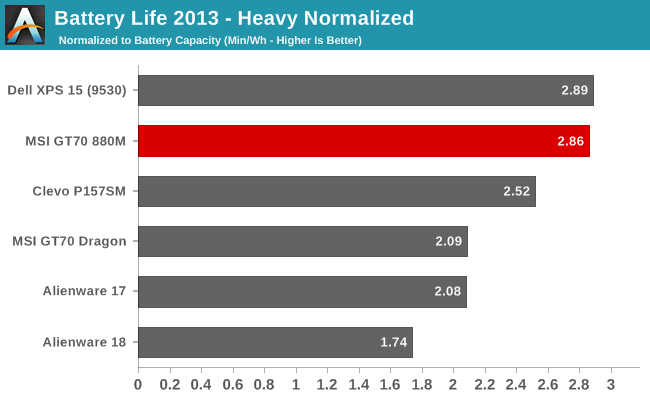
The updated GT70 shows a nice improvement in battery life compared to the previous model, though it should be noted that BIOS updates to the earlier GT70 Dragon did help as well. Perhaps even more impressive is the result in our Heavy workload, though at least some of the difference is due to the change in video playback software and the movie we use for testing. The Dell XPS 15 is the only other notebook in our charts to use the same file/player, and interestingly it’s only slightly ahead of the MSI GT70 (compared to easily surpassing it in the Light test). It looks like the GT70 is better optimized for performance over battery life in lighter loads, and while five hours of useful battery life won’t make it through an entire day for most people, it’s at least enough that you won’t need to pull out an AC adapter during a typical domestic flight. Unless you’re gaming, in which case you can expect closer to 1-1.5 hours, even with Battery Boost enabled; that’s the price of a high performance gaming notebook.
Temperatures and Noise
Running a “worst-case” 100% CPU+GPU workload, the GT70 does get quite toasty, but we’ve seen worse. Typical gaming temperatures (i.e. without loading all the CPU cores as well) run about 10C lower on the CPU and a 5-10C cooler on the GPU, and pure CPU loads are not really a concern at all. I’d be a hesitant to try running a fully loaded GT70 24/7, but for normal use where you’d only hit the system hard for a few minutes at a time, MSI’s GT70 should suffice. Even in our full stress-test workload, the CPU cores never dropped below 3.1GHz. The GPU dropped a bit lower – 875MHz – but this is really an atypical workload on both the CPU and GPU. If we turn off our GPU load and replace it with a game, the clocks don’t drop below 950MHz (at least, not that we’ve seen).
As for noise levels, not much has changed since our last look. At maximum load the GT70 fan generates 51.5dB from 18”, which is very loud – in fact, I’m pretty sure it has the dubious distinction of being the loudest notebook we’ve ever tested. This is really the major complaint we have with the single fan cooling arrangement. Games do tend to be a bit quieter (45dB), but if you're in a warmer environment you'll likely hear the full speed fan kick in.
The temperatures may or may not be “too high”, depending on whom you ask, but when other gaming notebooks never get above 45dB – and notebooks like the ASUS G750JH stay under 40dB – the GT70 makes a statement in a way that’s likely to turn heads with people wondering, “who turned on the blow dryer!?” Other notebook manufacturers have shown that it’s possible to put two largish fans into a 17” gaming chassis, so it’s not a matter of it being too difficult; instead, it appears MSI is simply content to stick with their several years old design, and perhaps pass along some of the cost savings to the users.


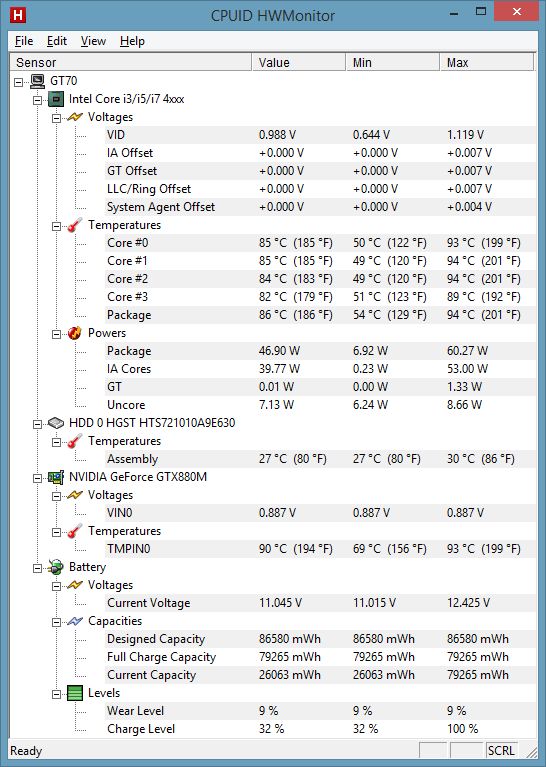
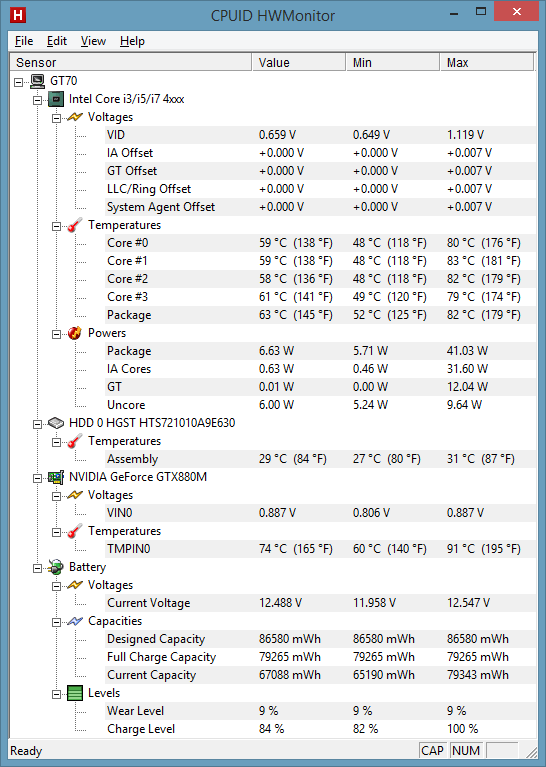








61 Comments
View All Comments
Hrel - Wednesday, April 16, 2014 - link
I've always wondered why laptop GPU's include so much extra GPU RAM. I've never seen a GTX660 with 4GB of RAM, much less 8. Yet I saw GTX460M's configured with 4GB of RAM years ago. What gives?Gunbuster - Wednesday, April 16, 2014 - link
It's a check box feature. That RAM is not that expensive and makes the system sound more impressive. It's not like they can stick a huge gaudy yellow three fan MSI cooler on the prefab graphics module they buy from Nvidia...ssiu - Wednesday, April 16, 2014 - link
And I always thought the 4GB on mobile GPUs are typos, since even desktop cards like 780Ti doesn't have 4GB. So they really have 4GB (and 8GB for this one)?? *mind blown*Batmeat - Wednesday, April 16, 2014 - link
I have the GE70. The machine is amazing. IMO save yourself the money and put your own SSD in. That's what I did.emarston - Thursday, April 17, 2014 - link
Same here, I popped in 2 SSDs in my GE70 and it's awesome.Harmattan - Wednesday, April 16, 2014 - link
Let's call this like it is... this is a 3 year-old laptop using a 1 1/2 year-old GPU. The 880m is the same exact chip as last year's 780m (which provides the same or better performance when overclocked) -- it's as if, in the desktop space, NVDA was to increase the GTX 780's core speed a bit and call it a "GTX 880". Further, the 880m is same chip as a 680m albeit with another shader block enabled. My issue is not the performance the 880m/780m provides, which is very good -- it's the fact that NVDA is sitting on tech and dribbling it out -- with virtually no cost improvement -- since there is no competition whatsoever at the high end. We need a high-end Maxwell mobile solution toute suite.Also, just a note on the pricing points you make at several points: this GT70 as configured is actually $50-100 more expensive than an NP8278/P170SM (which actually had some cosmetic changes since the last version, and has much better cooling) with the same hardware depending on the reseller -- not sure where you're pricing these machines...
Meaker10 - Wednesday, April 16, 2014 - link
Still has a much worse speaker setup and keyboard however.godlyatheist - Wednesday, April 16, 2014 - link
Where can you buy the i7-4700MQ 3 years ago? Oh wait, you can't.It's not a crime to use existing design and update them. They are faster (even if marginally) and not more expensive compared to the release price of the old gen equivalent. I don't get the problem here. It's not like they marketed the 680M laptop for $1000 and 880M ones for $2000.
"The 780m (which provides the same or better performance when overclocked)" That statement says the 880m improved because it is able to reach higher clock at same power envelope. You may think it's nothing, but you can't deny it's an improvement.
You said it yourself, there is no competition at the high end. Is it Nvidia's fault that AMD can't compete? Why should they do anything when refreshing existing design let's them reign with ease?
MSI has traditionally been weak in the cooling department, because they make budget gaming laptops. They are going to save the $$$ somewhere and cooling is what MSI chose. If you only care about specs, sure go with Sager/Clevo. All the other stuff surely aren't worth $50-100 right?
I have the P150HM/NP8150 with 2nd gen i7 + 680M and it runs any game I need comfortably. It has a dual fan design yet the cooling is crap unless you mod the casing. The reason is thin heatpipe and lack of air intake. Clevo has improved since then but it's the same as any other company. Oh yea, the keyboard is junk on it.
danwat1234 - Tuesday, April 22, 2014 - link
The MSI has a very high flow 12V cooling fan. If you crank the fan to full speed, temps will stay nice even at full load on all processors. Unless it's needs a repaste.pmpysz - Wednesday, April 16, 2014 - link
"ASUS is now using an IPS panel in their competing G750 series"What model? I've been looking at them all and haven't seen a single IPS panel in any of the G750s. Even the new ones with the 800 series GPUs.